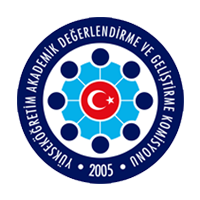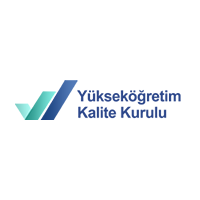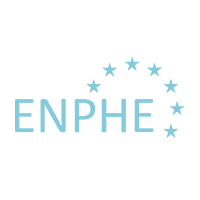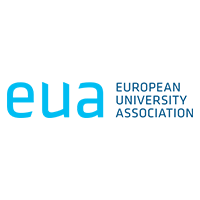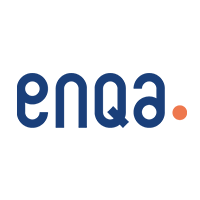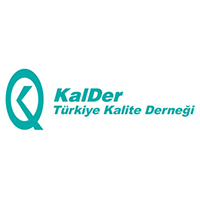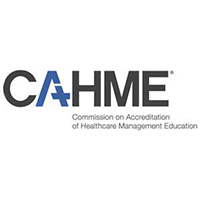ASSOCIATION REGULATIONS
ARTICLE 1: Name and Headquarters of the Association
The name of the association is "Health Sciences Education Programs Evaluation and Accreditation Association". The short name of the association is "SABAK" and it is mentioned with its short name in the following articles of the charter. The headquarters of the association is in Ankara and has no branch offices.
ARTICLE 2: Purpose and Fields of Activity of the Association
a. The main objective of SABAK is, accreditation for health education programs in different disciplines, making assessment and health sciences information studies in order to contribute to enhancing the quality of Health Sciences education in TURKEY. Thus, it is aimed to improve the welfare of the society by educating and more qualified health professionals who comprehend current and developing technologies.
b.SABAK carries out the following activities in order to achieve its purpose:
i. Evaluating and accrediting Health Sciences education programs upon the application of institutions
ii. Conducting the selection and training of evaluators to take part in accreditation studies,
iii. Informing and training the program managers and faculty members about program evaluation,
iv. Constantly monitoring the current and future needs of the stakeholders of health sciences programs, to determine the program evaluation criteria, to review and renew the evaluation criteria and processes when necessary,
v. Organizing courses, seminars, conferences, panels, workshops etc. meetings at national and international level in order to realize its goals, and supporting the activities within this scope,
vi. Communicating, cooperating, carrying out joint projects, helping each other with national and international associations, professional organizations and accreditation organizations regarding education, evaluation and accreditation,
vii. Making international mutual and multilateral recognition agreements,
viii. Being a member of relevant national and international organizations,
ix. To make or have it made made examinations and researches for the activation and development of its activities,
x. To obtain all kinds of information, documents, documents and publications required to achieve their objectives, to establish a documentation center, to create a web page, to announce their work, publishing publications such as newspapers, magazines, books, and to distribute them to their members, To prepare relevant printed, audio-visual material, to disseminate by mail and e-mail,
xi. To provide a healthy working environment in order to realize its goals, to provide all kinds of technical tools and equipment, fixtures and stationery materials,
xii. To engage in fundraising activities and to accept donations from Turkey and abroad in accordance with the procedures specified in the Law on Aid Collection No.2860 and provided that necessary permissions are obtained
xiii. Establishing and operating economic, commercial and industrial enterprises, or partnering with similar-purpose enterprises in order to obtain the incomes needed to achieve their goals
xiv. Buying, selling, renting and leasing movebles and immovables and establishing the same right on immovables, which are needed for activities,
xv. Establishing a federation or joining an established federation if deemed necessary for the realization of the purpose, establishing facilities that associations can establish with permission by obtaining the necessary permissions, establishing foundation associations with some of their properties,
xvi. To carry out joint projects with public institutions and organizations in matters that fall within their scope of duty, without prejudice to the provisions of the Law No. 5072 on Relations of Associations and Foundations with Public Institutions and Organizations, if deemed necessary to achieve their objectives,
vii. To create platforms to achieve a common goal with other associations, foundations, unions, unions and similar non-governmental organizations in areas related to its objectives and not prohibited by law.
ARTICLE 3: Membership Conditions and Admission to Membership
Real and legal persons who will support SABAK's objectives with their objectives and the activities they carry out can become a member of SABAK upon written application and by the decision of the Board of Directors.
ARTICLE 4: Participation of Members Carrying Out Management Tasks in Universities and Faculties in Program Evaluation and Accreditation Studies
SABAK members, those who are appointed to the positions of Rector, Vice Rector and Advisor to the Rector in universities, Dean and Vice Dean in Health Sciences Faculties, while carrying out these duties, do not participate in Program Evaluation and Accreditation studies in order to prevent possible conflicts of interest and / or conflicts during their duties. All other membership rights continue as they are.
ARTICLE 5: Unsubscription
Each member can unsubscribe from SABAK membership at any time by resigning. However, the resignation must be in written. As soon as the resignation petition of the member reaches the Board of Directors, the exit procedures are deemed to have been completed. Quitting membership does not end the accumulated debts of the member to the association. In the event of a unsubscription in membership due to death, debt follow-up is not made.
ARTICLE 6: Dismissal from Membership
Members who lose the conditions required by the laws and this regulations are dismissed from SABAK membership by the decision of the Board of Directors. The conditions that require dismissal from SABAK membership are listed below:
a. To act contrary to SABAK's statute,
b. Avoiding the duties given,
c. Not paying the membership fee within six months despite written warnings,
d. Failing to comply with the decisions made by SABAK organs,
e. Having lost the conditions for membership.
ARTICLE 7: Organs
The organs of SABAK are listed below:
a. General Assembly,
b. Board of Directors,
c. Supervisory Board,
New boards may be established in order to fulfill SABAK activities with the suggestion of the Board of Directors and the approval of the General Assembly.
ARTICLE 8: General Assembly
The General Assembly is the most authoritative decision-making body of SABAK and consists of members registered with SABAK. The Ordinary General Assembly convenes every year in November, on the day, place and time to be determined by the Board of Directors. Association member legal entities notify the Board of Directors of the Association together with the necessary authorization documents before the General Assembly by whom they will be represented in the General Assembly meeting.
ARTICLE 9: Call to the General Assembly and Meeting Quorum
a. The Board of Directors arranges the list of members entitled to participate in the General Assembly. The members entitled to attend the General Assembly are invited to the meeting by the Board of Directors by announcing the date, time, place and agenda in hard copy or notifying in writing or by e-mail at least fifteen days in advance. In this call, if the meeting cannot be held due to lack of quorum, the day, time and place of the second meeting will also be stated. The period between the first meeting and the second meeting cannot be less than seven days and more than sixty days.
b. If the meeting is postponed for any reason other than the reason for the lack of quorum, this situation is announced to the members in accordance with the call procedure made for the first meeting by stating the reasons for adjournment and the second meeting is called. The second meeting must be held within six months at the latest from the postponement date. The General Assembly meeting cannot be postponed more than once.
c. The General Assembly convenes with the participation of one more than half of the members who have the right to participate, and two thirds of them in case of a change in the statute and the termination of SABAK; In case the meeting is postponed due to lack of quorum, a quorum is not required in the second meeting. However, the number of members attending this meeting cannot be less than twice the total number of permanent members of the Board of Directors and Supervisory Boards.
ARTICLE 10: General Assembly Meeting Principles
a. Members who will attend the General Assembly can enter the meeting by signing opposite their names in the "Chart of General Assembly Members" prepared by the Board of Directors.
b. If the meeting quorum has been met, the situation is determined by a minute and the meeting is opened by the chairman of the Board of Directors or one of the members of the Board of Directors to be appointed. If the meeting quorum cannot be achieved, a minute is drawn up by the Board of Directors.
c. After the opening, the chairman, a vice chairman and a clerk are elected to manage the meeting and a three-person council committee is formed.
d. The management and security of the meeting belongs to the chairman of the council. The draft agenda of the General Assembly is prepared by the Board of Directors. The Council opens the draft agenda for discussion and votes and finalizes it, taking into consideration the amendment proposals received from the General Assembly members.
e. Each natural or legal representative member has one voting right in the General Assembly; the member must use the his/her vote personally.
f. In the General Assembly, the elections of the members of the Board of Directors and the Supervisory Board are made by secret ballot, whereas decisions on other issues are made by open voting, unless otherwise decided. Secret votes are the votes collected by the chairman of the council by putting the sealed papers or ballot papers into an empty container or box after the members are duly made, and determined by making an open breakdown after the end of the voting. In open voting, the method specified by the chairman of the council is applied.
g. The topics discussed and the decisions taken at the meeting are written in a minute and signed together by the council committee. At the end of the meeting, the minutes and other documents are delivered to the chairman of the Board of Directors. The chairman of the Board of Directors is responsible for protecting these documents and submitting them to the newly elected Board of Directors within seven days.
ARTICLE 11: Extraordinary General Assembly
a. When deemed necessary by the Board of Directors or the Supervisory Board or upon the written request of one fifth of the SABAK members, the General Assembly is called for an extraordinary meeting by the Board of Directors.
b.If the Board of Directors does not call the General Assembly for an extraordinary meeting within thirty days despite the written request of one fifth of the members of SABAK, the magistrate shall assign three members to convene the General Assembly upon the request of one of the members.
ARTICLE 12: Duties and Powers of the General Assembly
The duties and powers of the General Assembly are listed below:
a. To take the necessary decisions in line with the laws and the provisions of the statutes,
b.Discussing and approving the upcoming working period work program and budget, income and expense charts,
c. To determine the entrance fee and annual dues to be received from the members,
d. Discussing and approving the Board of Directors activity report, balance sheet and income-expense tables and Audit Board report for the past term of employment; Acquitting the Board of Directors
e. To elect the permanent and alternate members of the Board of Directors and Supervisory Boards for the next working period by secret voting,
f. Discussing and resolving the proposal of the Board of Directors regarding the amendment of the regulation,
g. To take decisions on the regulations prepared and proposed by the Board of Directors and the boards proposed to be created,
h. Authorizing the Board of Directors to purchase immovable property required for SABAK or to sell existing immovable properties
i. To take decisions about the recommendations made by the Board of Directors in relating SABAK to make international studies, to become a member of national and international organizations or to leave these organizations or to cooperate with them and to authorize the Board of Directors on these matters,
j. Deciding to establish partnerships, economic, commercial and industrial enterprises, funds and foundations, or to participate in those established or to be established,
k. To determine the principles to be used by the Board of Directors to determine the amount of daily and travel allowances to be given to the members of the Board of Directors who will be assigned for SABAK services and for all kinds of allowances, travel expenses and compensations,
l. To decide on the dissolution of SABAK and the distribution of its assets,
m. To examine and decide on other proposals proposed by the Board of Directors and to decide on the necessary issues.
ARTICLE 13: Board of Directors
The Board of Directors consists of five original and five substitute members elected by the General Assembly for a period of two years by secret voting. In the event of a vacancy from the main memberships, the substitute members are invited to duty according to the order of the votes they received in the election in the General Assembly. Members of the Board of Directors work on a voluntary basis; They cannot receive attendance fees for Board membership or for the Board of Directors meetings they attend. However, the expenses they make in order to carry out an activity related to the Association for which they are assigned, are c
ARTICLE 14: Working Principles of the Board of Directors
a. In its first meeting following the election of the Board of Directors, starts to work by electing a chairman, a vice chairman, a treasurer and a secretary member.
b. The Board of Directors convenes at least four times a year and may be called for an extraordinary meeting by the Chairman of the Board of Directors when necessary.
c. The Board of Directors meetings are opened and continued with the presence of at least three members; decisions are taken by the majority of those present at the meeting.
d. A member who does not attend three consecutive meetings without any excuse is deemed to have withdrawn.
e. After being signed with an electronic signature, the Board of Directors can also convene via video-conference or tele-conference by taking a print out, pasting it into the book and approved by the notary public.
ARTICLE 15: Duties and Powers of the Board of Directors
The duties and powers of the Board of Directors are listed below:
a.To do the work and procedures required in line with the laws and regulations, to make and implement decisions,
b.To implement the decisions taken by the General Assembly,
c. Representing SABAK through its president or giving representation power to other members when necessary,
d. To prepare the working period work schedule, budget, income-expense charts, submit them to the approval of the General Assembly and apply them,
e. To make the necessary examinations regarding the removal of members who require dismissal from membership, to decide on the exclusion of natural and legal persons,
f. To determine the date, time, place and agenda of the General Assembly meetings, to announce it to the members,
g, Preparing the last working period work report, balance sheet and income-expense tables and submitting them to the General Assembly,
h. Preparing the regulations regarding the structure, members and working principles of the Health Sciences Education Programs Accreditation Board (SAK) and, when necessary, preparing the changes in this regulation by taking the opinions of the SAK and submitting it to the approval of the General Assembly,
i. Preparing, changing and canceling the directives stipulated by SABAK regulations by taking the opinions of SAK and related parties when necessary,
j. When deemed necessary, to create proposals for the establishment of new boards that will work as the SABAK body in order to carry out the activities of SABAK and submit it to the approval of the General Assembly,
k.When deemed necessary, to establish advisory boards, committees and working groups that will work in SABAK's fields of activity and to examine the reports to be created by them and take decisions,
l. To appoint personnel and consultants to carry out the administrative and financial affairs of SABAK, to determine the wages to be paid to them and to terminate their jobs when necessary,
m. To formulate proposals on cooperation with national and international organizations in accordance with SABAK's objectives, to submit it to the approval of the General Assembly, to plan and carry out such activities based on the authority given by the General Assembly,
n.When deemed necessary, to carry out studies on the amendment of SABAK's bylaws and submit it to the approval of the General Assembly,
o.To decide on objections related to the actions of the SABAK bodies.
ARTICLE 16: Supervisory Board
a. The Supervisory Board consists of three principal and three substitute members elected by the General Assembly for a period of two years by secret ballot.
b.A member who does not attend three consecutive meetings without any excuse is deemed to have withdrawn.
c. If there is a vacancy from the principal memberships, the substitute members are invited to duty according to the order of the votes they received in the election in the General Assembly.
d. The Supervisory Board elects its chairman at its first meeting and notifies this to the Board of Directors in written.
e. The Supervisory Board meeting quorum is two.
f. The duties and powers of the Supervisory Board are listed below:
i. To inspect whether SABAK operates in line with the objectives set forth in its statute and the work subjects specified to be carried out for the realization of these objectives, whether the books, accounts and records are kept in accordance with the legislation, to inspect the results of the audit at least once a year and to the Board of Directors in the form of a written report.
ii. When deemed necessary or called upon, participating in the Board of Directors Meetings without voting right, and sharing their opinions and thoughts,
iii. To present the results of the audit to the General Assembly in the form of a jointly signed report.
ARTICLE 17: Health Sciences Education Programs Accreditation Board
The Health Sciences Education Programs Accreditation Board carries out the work required for the evaluation and accreditation of health science programs. The short name "SAK" is used. The structure, members and working principles of SAK are determined by a regulation prepared by the Board of Directors and approved by the General Assembly. The same method is followed for the changes to be made in this regulation.
ARTICLE 18: Revenues
SABAK's sources of income are listed below:
a. Entrance fees and annual dues to be received from private and legal members,
b. Donations (aids to be made in the form of goods and money for the realization of SABAK's objectives),
c. Deposit interest, repo, treasury bills and similar securities income,
d. Rental etc. incomes from movable and immovable properties
e. Income from events such as courses, seminars, training, program evaluation, program accreditation, publication etc. and other SABAK activities,
f. Income from the economic, commercial and industrial enterprises that SABAK has established, operated and partnered with in order to provide the income it needs to achieve its goals.
g. Other income permitted by applicable law.
The Board of Directors is authorized for activities to be carried out to generate income for SABAK. These revenues are collected only against receipts arranged in accordance with the principles specified in the Associations Law. The person giving the money and collecting money has his / her clear identity and signature on the receipt. The Board of Directors may authorize one or more of its members individually or jointly by decision to collect revenues, make expenditures, and withdraw money from the bank. This situation does not eliminate the legal liability of other Board members.
ARTICLE 19: Internal Audit of the Association
In SABAK, internal audits can be carried out by the General Assembly, Board of Directors or the Supervisory Board, as well as by independent audit institutions. The fact that an audit has been carried out by the General Assembly, Board of Directors or independent audit institutions does not remove the Supervisory Board's obligation.
ARTICLE 20: Borrowing Procedures of the Association
SABAK may borrow with the decision of the Board of Directors, if needed in order to achieve its purpose and to carry out its activities. This borrowing can be in the purchase of goods and services on credit or in cash. However, this borrowing cannot be made in amounts that cannot be covered by SABAK's income sources and can not be in a nature that will reduce SABAK's payment difficulty. Can not exceed half of the its budget revenues approved by the General Assembly for that year or extend to new working periods. The Board of Directors can borrow larger amounts on a project basis with the decision of the General Assembly.
ARTICLE 21: Termination of the Association and Liquidation Method of Assets
The SABAK General Assembly can always decide to dissolve SABAK. In order to discuss the termination issue at the General Assembly, 2/3 majority of the members entitled to attend the General Assembly is required. In case the meeting is postponed due to lack of majority, majority is not required in the second meeting. However, the number of members attending this meeting cannot be less than twice the total number of members of the Board of Directors and Audit Boards.
The majority of decision required for the termination decision is 2/3 of the votes of the members attending the meeting. Decision of termination voting is made openly in the General Assembly.
When the dissolution decision is taken by the General Assembly, the liquidation is carried out by the liquidation committee consisting of the last Board members. These procedures are initiated from the date of the General Assembly decision regarding dissolution or when the automatic termination is finalized. The phrase "Association for Evaluation and Accreditation of Health Sciences Education Programs in liquidation" is used in the name of SABAK in all transactions during the liquidation period.
The liquidation committee is in charge and authorized to complete the liquidation of SABAK's money, property and rights from the beginning to the end in accordance with the legislation. This board first examines the association's accounts. During the examination, the books, receipts, expenditure documents, title deeds, bank records and other documents of the association are determined and their assets and liabilities are recorded in a report. During the liquidation process, the creditors of the association are called and its assets, if any, are converted into cash and paid to the creditors. If the association is creditor, the receivables are collected. After the collection of the receivables and the payment of the debts, all remaining money, property and rights are transferred to the place determined in the General Assembly. In the General Assembly, if the place to be transferred is not determined, it is transferred to the association that is closest to the purpose of the province and SABAK and has the most members on the date of termination.
All transactions related to the liquidation are shown in the liquidation report and the liquidation procedures are completed within three months, except for the additional periods given by the local administrative authorities based on a just cause.
Following the completion of the liquidation and transfer procedures of the money, property and rights of the association, the liquidation committee must notify the local administrative authority of the location of the association's headquarters in a letter within seven days and attach the liquidation report to this letter.
The last members of the Board of Directors are responsible for keeping the books and documents of the association as the liquidation committee. This duty can be conferred to a member of the board too. These books and records must be kept for five years.
ARTICLE 22: Lack of Provision
The Law on Associations in force, the Turkish Civil Code and the Associations Regulation issued in reference to these Laws and the provisions on associations of other relevant legislation shall apply to matters not specified in this charter.
ARTICLE 23: Regulation Amendment
a. The regulation change can be made with the decision of the general assembly. A majority of 2/3 of the members who have the right to attend the general assembly is required in order to make a change in the regulation in the general assembly. In case the meeting is postponed due to lack of majority, majority is not required in the second meeting. However, the number of members attending this meeting cannot be less than twice the total number of members of the board of directors and auditors.
b. The decision majority required for the amendment of the regulation is 2/3 of the votes of the members who attend the meeting and have the right to vote. By-laws change voting is made openly in the general assembly.
PROVISIONAL ARTICLE 1: Temporary Entrance Fee and Annual Fee
Until the first General Assembly is convened, the entrance fee of all real and legal members is 50 TL and the annual membership fee is 50 TL.
This regulation consists of 23 articles and 1 provisional article.
TEMPORARY BOARD OF DIRECTORS
1. Gülsüm Aydan Genç (Chairman)
2. Özlem Ülger (Vice President)
3. Gonca Bumin (Treasurer)
4. Hülya Gökmen Özel (Secretary General)
5. Meral Huri (Member)
6. Çiğdem Ayhan (Member)
7. Mine Baydan Aydemir (Member)

